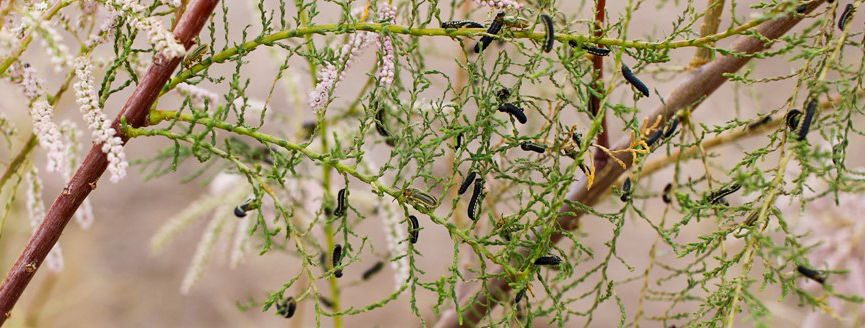By Ann Larson
Oklahoma County Extension Master Gardener
Every year, about this time, I get a new calendar just for gardening reminders. This year the first thing I did was circle the month of May and write in big, bold, block letters: BAGWORMS.
I missed it last year and was horrified when I finally discovered their masses in the fall.
I have to admit, I had been preoccupied for a few years with an ailing spouse. Life can sometimes get in the way of gardening to the point of neglect, even with a calendar.
That’s what happened when I discovered that bagworms had invaded. Not until I noticed a little Common Chokecherry was defoliated before its time and found a bagworm clinging to a bare branch, did I bother to look up.
Bagworms by the thousands—I am not exaggerating—were dangling like ornaments from the branches of the neighborhood’s Eastern red cedars (Juniperus virginiana—the plague of the plains and bagworms’ favorite food).
These trees line the greenbelt behind my fence and arch over my flowerbeds. I became utterly distressed as I noticed these pests hovering continuously along the fence line. Their pinecone-shaped coverings were strongly anchored, not only to the junipers but to many of my trees and shrubs and even the stockade fence itself.
I knew I had missed the ideal time for treatment (late May, June), and I knew that if action wasn’t taken soon, there would be nothing left but stripped down trees that would provide no barrier to the noise from the busy street beyond the greenbelt and create an even worse fire hazard to boot.
I called the neighborhood association and they were quick to respond, but they sprayed broadly. What’s a Master Gardener to do? I closed my eyes to the pesticide drift.
And when I finally opened them, I found a layer of bagworms blanketing my flowerbeds and overflowing into my yard and yet there were still more cocoons dangling stubbornly from on high.
I plucked those I could reach: 16 from one measly branch. Yes, I counted. I began picking them out of the yarrow and raking them from beneath the evergreen shrubs, sifting through the compost like a miner panning for gold. These nuggets that had fallen weren’t sparkly and gold—only the berry-laden casings were easy to find in the dark dirt.
Exhausted after filling four 30-gallon trash bags from one mere stretch, I called my friends at the Oklahoma County Extension Master Gardener call center to ask if I really needed to clean up all those that had dropped. I was hoping for some magic (quick and easy) solution.
From my Master Gardener classes, I remembered when to spray (late May through June) and what to use to spray (a pesticide containing Bacillus thuringiensis (B.t.) subsp. kurstaki); even what flowers to plant (Shasta daisies and asters) to draw bagworms’ enemies, predatory beneficial insects such as parasitic wasps.
But I had no idea how much damage would be caused if I left this layer of sprayed bagworms covering my gardens like an ugly brown blanket. The call center encouraged me to continue removing them. They had no idea how daunting a task was at hand.
My granddaughter was visiting so I put her to work as well. From beneath an Acadiana holly, she gathered a large bucketful. And then it hit me: How many buckets of bagworms make for a positive bonding experience? At what point does the task become detrimental to relationships?
A few more bucketsful and I could tell she had lost interest. Nature would just have to take its course….until spring when we can plant daisies and asters. I’ve noted that in the margins of my 2018 garden calendar, as well.
Sometimes you just need a bagworm moment to figure out what matters most.

